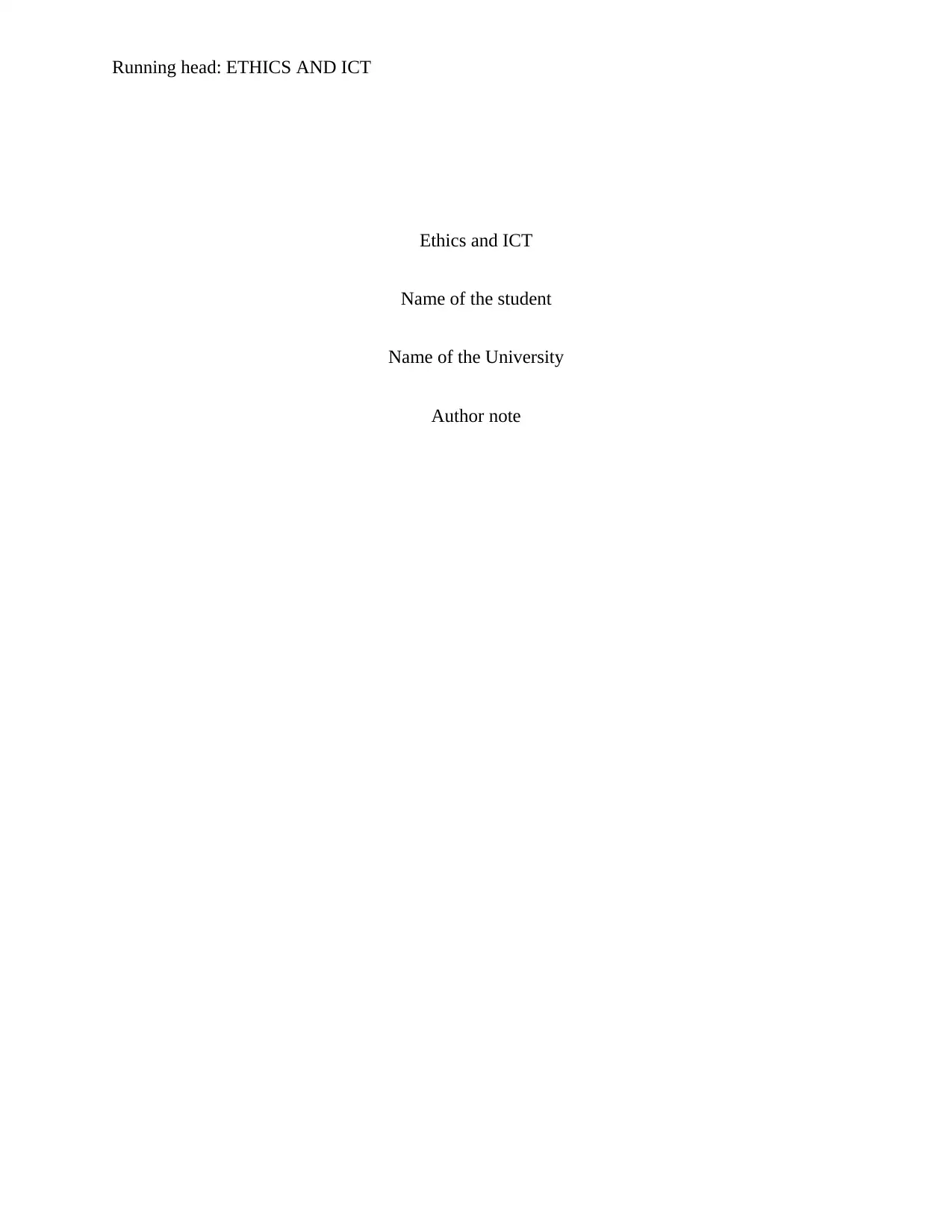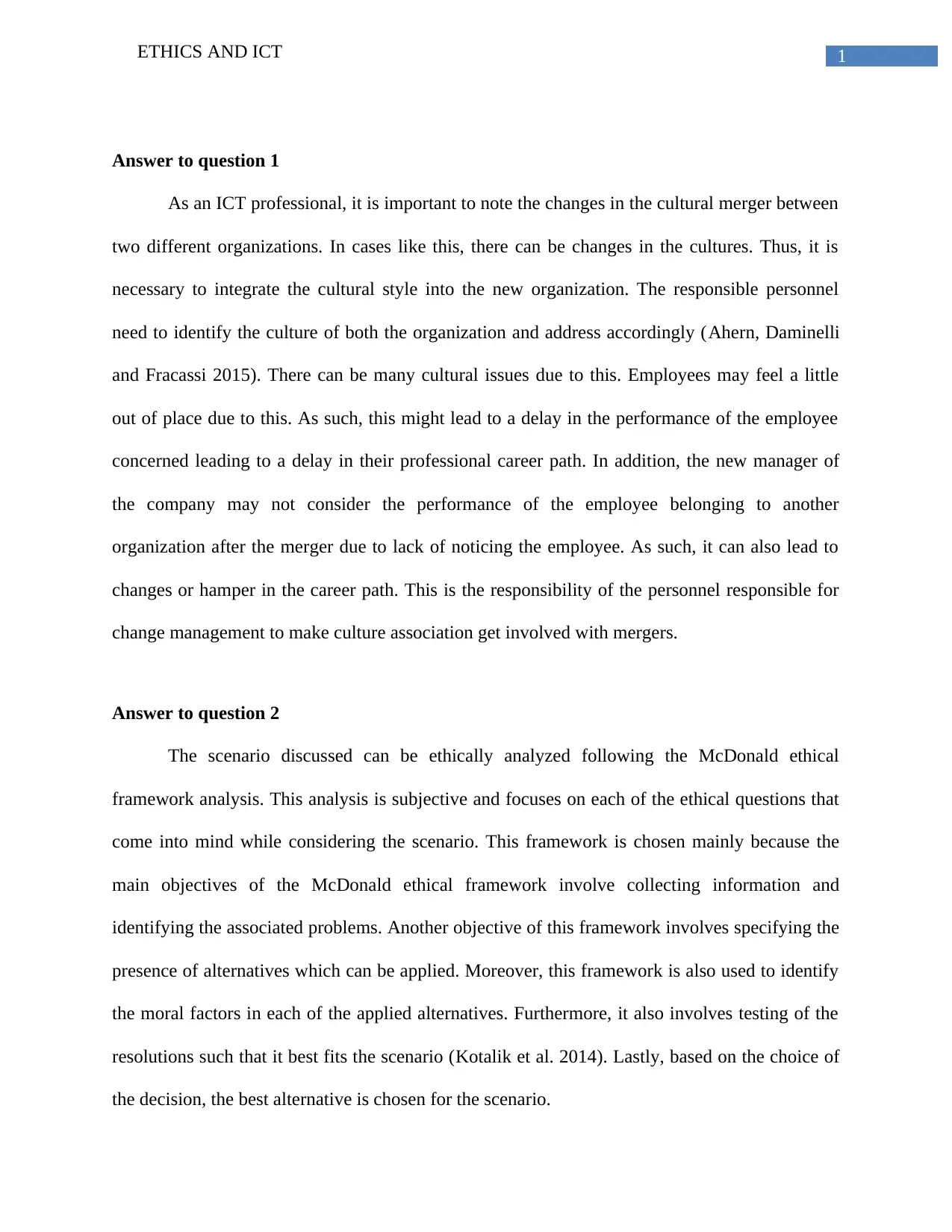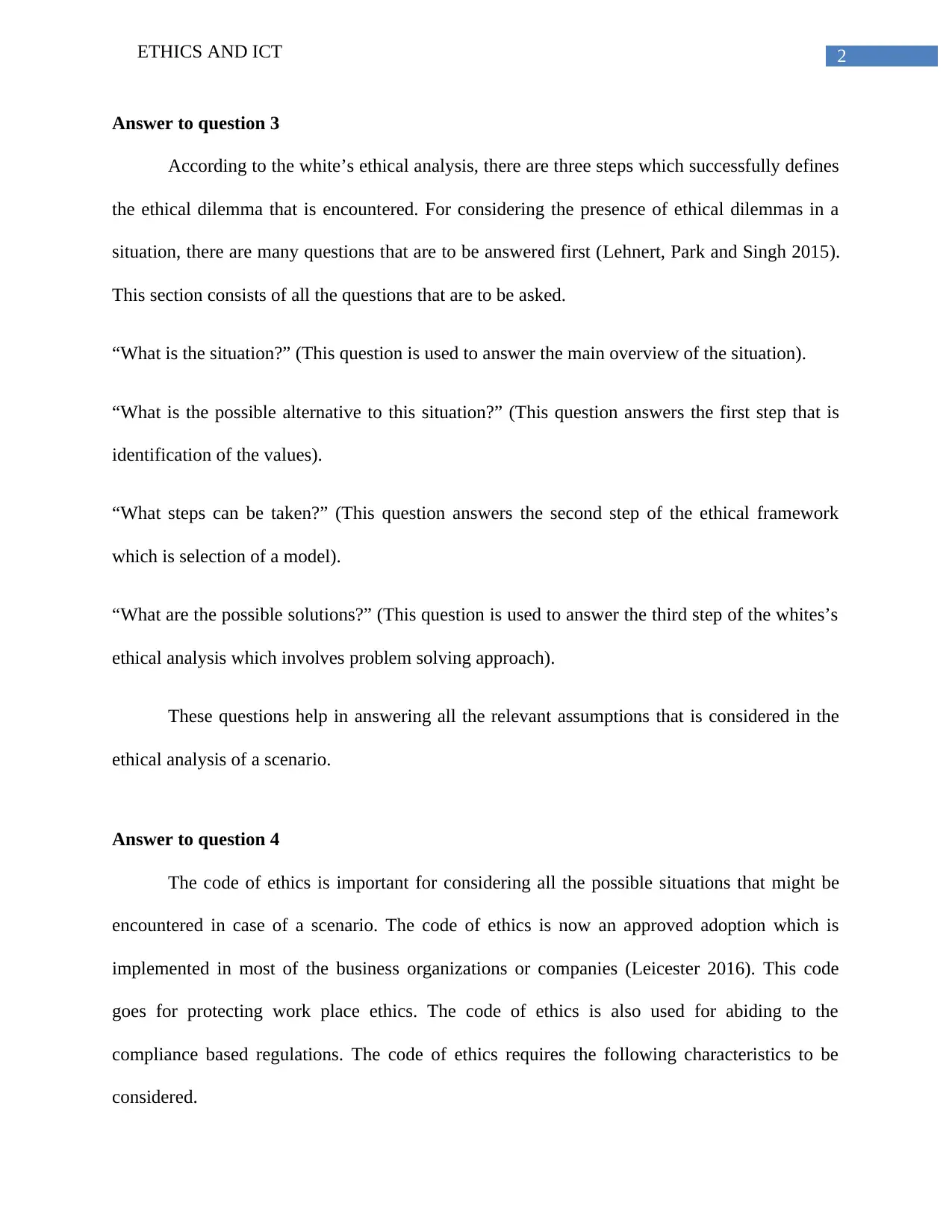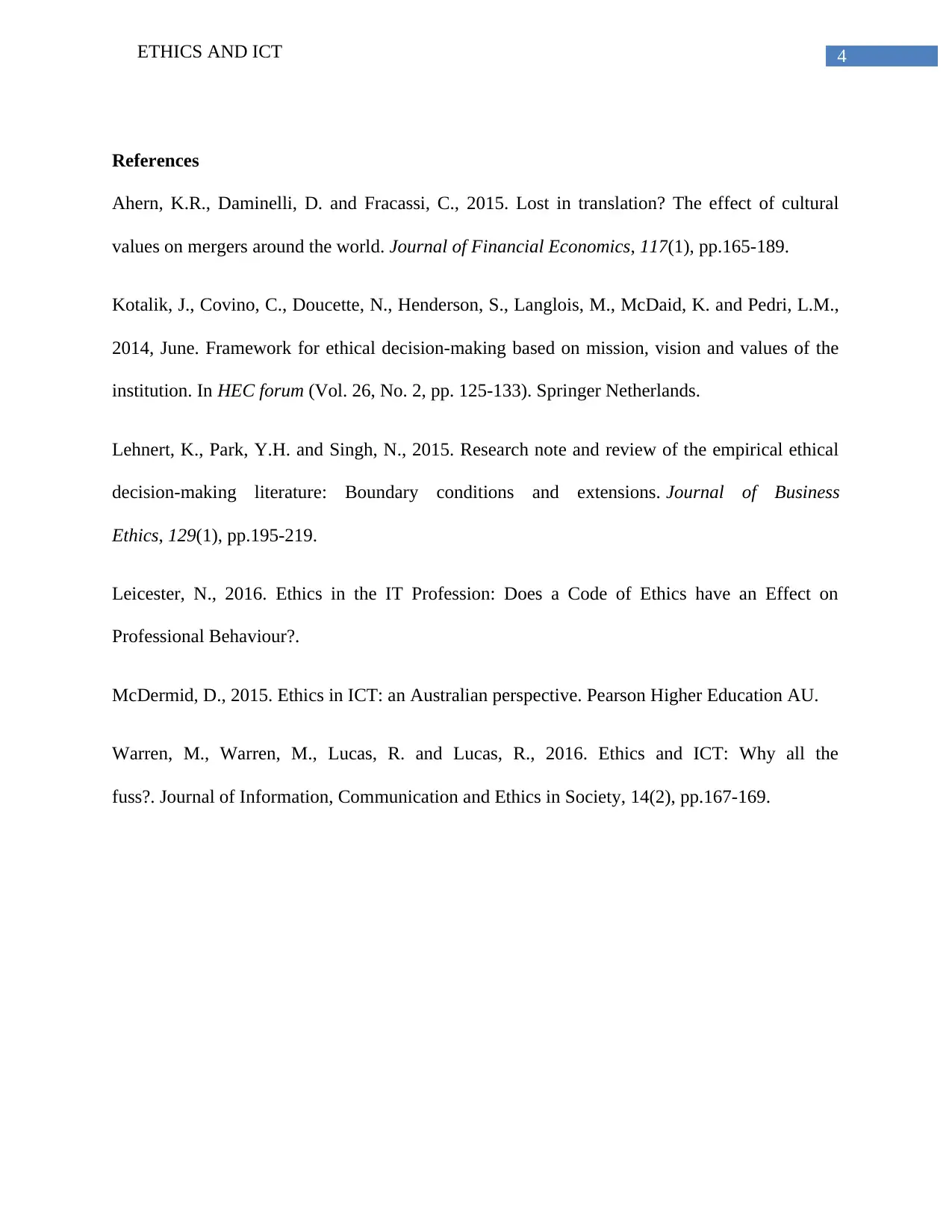Ethical Analysis of ICT: Cultural Issues and Code of Ethics
VerifiedAdded on 2020/05/28
|5
|1140
|72
Homework Assignment
AI Summary
This assignment addresses ethical considerations within the field of Information and Communication Technology (ICT). It begins by examining the impact of cultural mergers between organizations, highlighting potential issues such as employee displacement and career path disruptions, and emphasizes the need for effective change management. The assignment then applies the McDonald ethical framework to analyze a given scenario, emphasizing information gathering, problem identification, and the evaluation of alternative solutions. Furthermore, it explores White's ethical analysis, outlining the key questions necessary for identifying ethical dilemmas and defining the steps involved in problem-solving. The importance of a code of ethics in ICT is then discussed, focusing on key characteristics like personal integrity, accountability, and the value of relationships. The document concludes by pointing out the broader scope of professional conduct and the limitations of a code of ethics.

Running head: ETHICS AND ICT
Ethics and ICT
Name of the student
Name of the University
Author note
Ethics and ICT
Name of the student
Name of the University
Author note
Paraphrase This Document
Need a fresh take? Get an instant paraphrase of this document with our AI Paraphraser

1ETHICS AND ICT
Answer to question 1
As an ICT professional, it is important to note the changes in the cultural merger between
two different organizations. In cases like this, there can be changes in the cultures. Thus, it is
necessary to integrate the cultural style into the new organization. The responsible personnel
need to identify the culture of both the organization and address accordingly (Ahern, Daminelli
and Fracassi 2015). There can be many cultural issues due to this. Employees may feel a little
out of place due to this. As such, this might lead to a delay in the performance of the employee
concerned leading to a delay in their professional career path. In addition, the new manager of
the company may not consider the performance of the employee belonging to another
organization after the merger due to lack of noticing the employee. As such, it can also lead to
changes or hamper in the career path. This is the responsibility of the personnel responsible for
change management to make culture association get involved with mergers.
Answer to question 2
The scenario discussed can be ethically analyzed following the McDonald ethical
framework analysis. This analysis is subjective and focuses on each of the ethical questions that
come into mind while considering the scenario. This framework is chosen mainly because the
main objectives of the McDonald ethical framework involve collecting information and
identifying the associated problems. Another objective of this framework involves specifying the
presence of alternatives which can be applied. Moreover, this framework is also used to identify
the moral factors in each of the applied alternatives. Furthermore, it also involves testing of the
resolutions such that it best fits the scenario (Kotalik et al. 2014). Lastly, based on the choice of
the decision, the best alternative is chosen for the scenario.
Answer to question 1
As an ICT professional, it is important to note the changes in the cultural merger between
two different organizations. In cases like this, there can be changes in the cultures. Thus, it is
necessary to integrate the cultural style into the new organization. The responsible personnel
need to identify the culture of both the organization and address accordingly (Ahern, Daminelli
and Fracassi 2015). There can be many cultural issues due to this. Employees may feel a little
out of place due to this. As such, this might lead to a delay in the performance of the employee
concerned leading to a delay in their professional career path. In addition, the new manager of
the company may not consider the performance of the employee belonging to another
organization after the merger due to lack of noticing the employee. As such, it can also lead to
changes or hamper in the career path. This is the responsibility of the personnel responsible for
change management to make culture association get involved with mergers.
Answer to question 2
The scenario discussed can be ethically analyzed following the McDonald ethical
framework analysis. This analysis is subjective and focuses on each of the ethical questions that
come into mind while considering the scenario. This framework is chosen mainly because the
main objectives of the McDonald ethical framework involve collecting information and
identifying the associated problems. Another objective of this framework involves specifying the
presence of alternatives which can be applied. Moreover, this framework is also used to identify
the moral factors in each of the applied alternatives. Furthermore, it also involves testing of the
resolutions such that it best fits the scenario (Kotalik et al. 2014). Lastly, based on the choice of
the decision, the best alternative is chosen for the scenario.

2ETHICS AND ICT
Answer to question 3
According to the white’s ethical analysis, there are three steps which successfully defines
the ethical dilemma that is encountered. For considering the presence of ethical dilemmas in a
situation, there are many questions that are to be answered first (Lehnert, Park and Singh 2015).
This section consists of all the questions that are to be asked.
“What is the situation?” (This question is used to answer the main overview of the situation).
“What is the possible alternative to this situation?” (This question answers the first step that is
identification of the values).
“What steps can be taken?” (This question answers the second step of the ethical framework
which is selection of a model).
“What are the possible solutions?” (This question is used to answer the third step of the whites’s
ethical analysis which involves problem solving approach).
These questions help in answering all the relevant assumptions that is considered in the
ethical analysis of a scenario.
Answer to question 4
The code of ethics is important for considering all the possible situations that might be
encountered in case of a scenario. The code of ethics is now an approved adoption which is
implemented in most of the business organizations or companies (Leicester 2016). This code
goes for protecting work place ethics. The code of ethics is also used for abiding to the
compliance based regulations. The code of ethics requires the following characteristics to be
considered.
Answer to question 3
According to the white’s ethical analysis, there are three steps which successfully defines
the ethical dilemma that is encountered. For considering the presence of ethical dilemmas in a
situation, there are many questions that are to be answered first (Lehnert, Park and Singh 2015).
This section consists of all the questions that are to be asked.
“What is the situation?” (This question is used to answer the main overview of the situation).
“What is the possible alternative to this situation?” (This question answers the first step that is
identification of the values).
“What steps can be taken?” (This question answers the second step of the ethical framework
which is selection of a model).
“What are the possible solutions?” (This question is used to answer the third step of the whites’s
ethical analysis which involves problem solving approach).
These questions help in answering all the relevant assumptions that is considered in the
ethical analysis of a scenario.
Answer to question 4
The code of ethics is important for considering all the possible situations that might be
encountered in case of a scenario. The code of ethics is now an approved adoption which is
implemented in most of the business organizations or companies (Leicester 2016). This code
goes for protecting work place ethics. The code of ethics is also used for abiding to the
compliance based regulations. The code of ethics requires the following characteristics to be
considered.
⊘ This is a preview!⊘
Do you want full access?
Subscribe today to unlock all pages.

Trusted by 1+ million students worldwide

3ETHICS AND ICT
Personal Integrity
The presence of this trait helps in making a person more friendly and caring towards
others. This also helps in bringing out the honesty in the personality of an employee. As a
company requires involving external stakeholders, the employees are to remain honest and
caring in their transactions such that effective business process is emphasized (Warren et al.
2016). It is also used to relate to the good of the public.
Accountability
By utilizing this trait, a person can be counted to be responsible for the resources they are
in charge of. It also helps us to get a general idea of the resources to be needed for carrying out
the activities required (McDermid 2015). These resources may range from financial to personal
and might have an impact on their professional life as well. This is the main reason for an
employee to be accountable in their actions.
Relationships
A person present in the company need to value the relationship with other stakeholder.
For example, an employee must be kind towards other employees which will help in building
trust. This will also help in making a strong point if communication with clients and external
stakeholders are considered to be professional.
However, the code of professional conduct is a much large concept which is missing
from the code of ethics. Moreover, there are several clauses that are also not mentioned in the
code as well.
Personal Integrity
The presence of this trait helps in making a person more friendly and caring towards
others. This also helps in bringing out the honesty in the personality of an employee. As a
company requires involving external stakeholders, the employees are to remain honest and
caring in their transactions such that effective business process is emphasized (Warren et al.
2016). It is also used to relate to the good of the public.
Accountability
By utilizing this trait, a person can be counted to be responsible for the resources they are
in charge of. It also helps us to get a general idea of the resources to be needed for carrying out
the activities required (McDermid 2015). These resources may range from financial to personal
and might have an impact on their professional life as well. This is the main reason for an
employee to be accountable in their actions.
Relationships
A person present in the company need to value the relationship with other stakeholder.
For example, an employee must be kind towards other employees which will help in building
trust. This will also help in making a strong point if communication with clients and external
stakeholders are considered to be professional.
However, the code of professional conduct is a much large concept which is missing
from the code of ethics. Moreover, there are several clauses that are also not mentioned in the
code as well.
Paraphrase This Document
Need a fresh take? Get an instant paraphrase of this document with our AI Paraphraser

4ETHICS AND ICT
References
Ahern, K.R., Daminelli, D. and Fracassi, C., 2015. Lost in translation? The effect of cultural
values on mergers around the world. Journal of Financial Economics, 117(1), pp.165-189.
Kotalik, J., Covino, C., Doucette, N., Henderson, S., Langlois, M., McDaid, K. and Pedri, L.M.,
2014, June. Framework for ethical decision-making based on mission, vision and values of the
institution. In HEC forum (Vol. 26, No. 2, pp. 125-133). Springer Netherlands.
Lehnert, K., Park, Y.H. and Singh, N., 2015. Research note and review of the empirical ethical
decision-making literature: Boundary conditions and extensions. Journal of Business
Ethics, 129(1), pp.195-219.
Leicester, N., 2016. Ethics in the IT Profession: Does a Code of Ethics have an Effect on
Professional Behaviour?.
McDermid, D., 2015. Ethics in ICT: an Australian perspective. Pearson Higher Education AU.
Warren, M., Warren, M., Lucas, R. and Lucas, R., 2016. Ethics and ICT: Why all the
fuss?. Journal of Information, Communication and Ethics in Society, 14(2), pp.167-169.
References
Ahern, K.R., Daminelli, D. and Fracassi, C., 2015. Lost in translation? The effect of cultural
values on mergers around the world. Journal of Financial Economics, 117(1), pp.165-189.
Kotalik, J., Covino, C., Doucette, N., Henderson, S., Langlois, M., McDaid, K. and Pedri, L.M.,
2014, June. Framework for ethical decision-making based on mission, vision and values of the
institution. In HEC forum (Vol. 26, No. 2, pp. 125-133). Springer Netherlands.
Lehnert, K., Park, Y.H. and Singh, N., 2015. Research note and review of the empirical ethical
decision-making literature: Boundary conditions and extensions. Journal of Business
Ethics, 129(1), pp.195-219.
Leicester, N., 2016. Ethics in the IT Profession: Does a Code of Ethics have an Effect on
Professional Behaviour?.
McDermid, D., 2015. Ethics in ICT: an Australian perspective. Pearson Higher Education AU.
Warren, M., Warren, M., Lucas, R. and Lucas, R., 2016. Ethics and ICT: Why all the
fuss?. Journal of Information, Communication and Ethics in Society, 14(2), pp.167-169.
1 out of 5
Related Documents
Your All-in-One AI-Powered Toolkit for Academic Success.
+13062052269
info@desklib.com
Available 24*7 on WhatsApp / Email
![[object Object]](/_next/static/media/star-bottom.7253800d.svg)
Unlock your academic potential
Copyright © 2020–2025 A2Z Services. All Rights Reserved. Developed and managed by ZUCOL.



